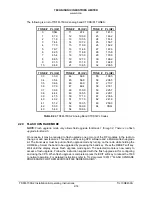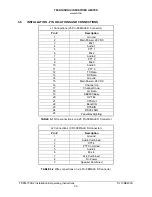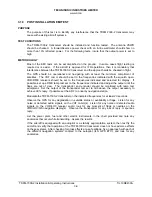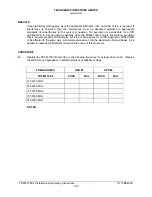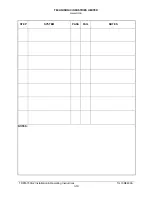
TECHNISONIC INDUSTRIES LIMITED
www.til.ca
TDFM-7300-2 Installation & Operating Instructions
TiL 10RE430A
3-5
3.12
PTT 1, 2, 3, 4, 5 and COMBINED:
J1 (PINS 5, 8, 11), J2 (PINS 3, 4) and P1 (PIN 14)
The PTT lines should be floating when in receive and grounded for transmit. The input has a pull
up resistor to 5 volts. Connecting an audio panel that wishes to see more, may result in no
receive audio. Connect a 1N4006 diode in series with the cathode towards the audio panel in this
case.
3.13 TX DATA AND RX DATA:
J1 (PINS 12 AND 13)
These pins provide RS-232 serial communications for use with the RC-7000 or RC-7300 remote
control head if installed. Consult the RC-7300 installation manual for details.
3.14
CHANNEL UP / DOWN:
J1 (PINS 16 AND 17)
These pins can be used to scroll up and down through the zone/channel/mode/talk group
selections for the band currently displayed on the screen. The inputs normally floating are
grounded to activate. Two push buttons or a center off, SPDT, spring loaded toggle switch are
typically used on these inputs. If both pins are grounded simultaneously, the next band will be
selected.
3.15
LH DATA, SB9600 BUSY, OPTB+, CTS OUT, BOOT DIN, RTSBIN AND RS232DIN:
J1 (PINS 18 THROUGH 24)
These pins are used for programming or updating the transceiver using Motorola Customer
Programming Software (CPS™) or encryption key loading and are left unconnected. They may
be used to update the radio once it is removed from the aircraft. These pins are also brought out
to the TDFM-7300’s front panel mini-DIN connector to allow programming in the aircraft.
3.16 PANEL
BACKLIGHTING:
J1 (PIN 25)
Connect to aircraft panel dimming bus. The transceiver is capable of supporting 28 VDC or 5
VAC backlighting circuits. Select 28 volts DC or 5 volts AC via the configuration menu (see
section 2.18). No damage will occur if the wrong setting is made.
3.17
ANTENNA TUNER CONTROL LINES:
P1 (PINS 1, 2, 3, 4, 5, 6, 10 AND 12)
These connections are to control an antenna tuner system such as the Foxtronics FLX-3050B.
Connect according to the manufacturer’s instructions. In the case of the FLX-3050B, the tune
indicator which is normally connected to a light, can be connected to pin 10 so that the tuning
indication will show on the TDFM-7300-2 display. If a passive antenna is used, these lines shall
remain unconnected.
3.18 POWER
JUMPER
The radio must be turned on manually each time the avionics bus is switched on. If it is desired
that the radio comes on with the radio master in the aircraft, remove the right side panel from the
radio and install the supplied 0.1” jumper across JP1 (two pins) near the rear of the radio on the
right side of the MCU board. The radio is shipped with the jumper on only one of the two pins. If
you attempt to turn off the radio with the jumper installed, it will come back on again in 5 seconds.
Turning the avionics bus or battery master switch off will be required to de-energize the radio.








